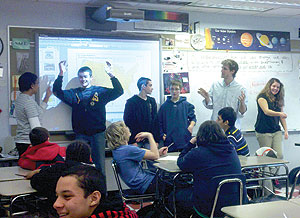
Students at the Kennedy School, all of whom are participating in the Kids Green their Schools program, act out all of the steps that must occur to enable individuals to watch television, from the power plant to the set.
By Cathleen Twardzik
At least eight science classes at the Kennedy School in Somerville will learn how to save energy this year by participating in the Kids Green their Schools program, which was created by “e” Inc.
This program, which was sponsored by NSTAR Electric, teaches kids where energy comes from, how they personally use it, and how they can save it, at school and at home. Each class of kids will target a specific conservation task, so that the Kennedy School may save energy. Kids will create and give conservation kits to teachers and students.
The kits consist of posters, an informative newsletter, and an index card, which serves as a reminder, that may be positioned over light switches.
Schools in Roslindale, Dorchester, Charlestown, Jamaica Plain, South End and Brighton are also participating in the program this year.
Including Kids Green their Schools, “e” Inc. designs all of its curricula. Its programs are structured to ensure that students gain science knowledge, along with documented increases in science test performance of 30 to 40 percent.
The company’s programs are unique because knowledge is paired with action, and they consider students to be environmentally responsible citizens, all of who may make a difference in their schools and communities.
“e” Inc. is an environmental science learning and action center that combines science education with community action, which leads to environmental change in urban communities. Its mission is to create dynamic, environmental citizens, all of whom are committed to the understanding of and to the protection of the earth.
Numerous hands-on activities, all of which were extremely satisfying for students, filled the lessons. The focus was to help students to comprehend where energy comes from, methods to reduce each person’s energy consumption, and the environmental impacts of each energy supply.
“Nate Baum from “e” Inc. came to my classroom on five consecutive Tuesdays to teach lessons around the concepts of consumption and reduction of fossil fuel use,” said Anthony Sharp, Seventh to 8th Grade Science Teacher at the Kennedy School in Somerville.
The goals of Baum’s visits were to raise awareness and to discover how to reduce Sharp’s classes’ own carbon footprint.
Baum asked students which appliances they could see around the room, which may be wasting energy. Kids noticed a set of speakers, a clock, a television and lamps, which were in use.
He showed the group a spreadsheet which documented the total money that their classroom was wasting per year by leaving various appliances on. That amount was $151. Since the Kennedy School has many classrooms, the building could save a great deal of money via energy conservation.
One of the messages of Kids Green their Schools is that all of earth’s energy currently comes from the sun. For example, the energy in apples comes from photosynthesis, which is a chemical reaction that allows plants to use sunlight to grow. Baum gave apples to the kids in the class and told them that they were using the sun’s energy each time that they ate.
Additionally, kids built simplified steam engines to learn how power plants work. “The steam spins the turbine,” said Baum. Turbines take mechanical energy and convert that rotation to electrical power. The children learned that the energy which runs many power plants in the United States comes from the sun, because photosynthesis created energy reserves of coal and natural gas, which are in existence at present.
To discover how coal and natural gas resources are non-renewable and decrease over time, the students in Baum’s class looked for beans, which he had hidden in their schoolyard. Each time they looked in the schoolyard, fewer and fewer beans remained.
Then, students drew graphs of the number of beans that they had found, and they used the exercise as a simile for extracting resources from the ground. Therefore, when companies extract coal and oil, resources dwindle.
Along with the assistance of “e” Inc, Sharp and his students started a campaign at the Kennedy to reduce consumption and to raise awareness. That included students going to classrooms to deliver brief presentations and hanging light switch reminder cards and posters. This initiative was very well supported at the school.
It must be noted that, at the Kennedy, “The largest portion of our energy use comes from lighting, and by simply turning off lights in rooms that are not occupied we can have a significant impact on reducing our consumption,” said Sharp.
This year marks the first that the Kennedy school has worked with “e” Inc. However, last year, Sharp’s classes worked on a very successful project with Honeywell Act Earth. That program’s energy consumption saved the Kennedy several thousand dollars on the school’s electric bill.
As a teacher, “The most rewarding thing for me is when a student will approach me and tell me what they did recently to reduce consumption. My students are passionate about caring for the planet on which they live, and I have an opportunity to help them understand the complexities of how human beings impact the ecology of our planet, and hopefully, [to] teach them how better to live in harmony with all the other living things, here on Earth,” said Sharp.
“I’m not sure if we will be working with any outside partners, around the concepts [of] energy use next year, but consumption and reduction will always be a part of my curriculum, and there is no better audience than the exceptional students at the Kennedy School,” he said.















Reader Comments